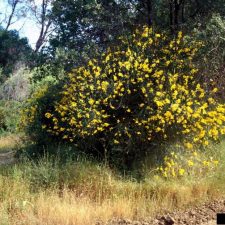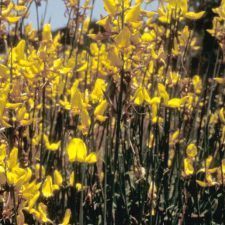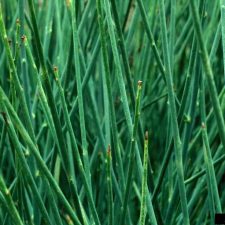
Photo credit: Jennifer Andreas, Washington State University, Bugwood.org
Management Category
Squamish
Whistler
Pemberton
Vectors of Spread
Synonyms
- Rush broom
- Weaver’s broom
- Genet
ID Characteristics
General: Spanish broom is a perennial, deciduous shrub that lives up to four years.
Flowers: Yellow, pea-like and fragrant. The flowers grow at the end of the stem and are up to 3 cm long.
Stems: Long, waxy, slender, cylindrical and erect with few branches or spines. Spanish broom has round stems (unlike other brooms), which aids identification.
Leaves: Spanish broom leaves are small (1 – 2 cm long), oval with smooth margins. They only remain on the plant for 4 months or less, giving the plant a leafless appearance much of the year.
Fruits: Spanish broom produces pea-like pods which are 4 – 10 cm long. When mature, the pods are dark brown, covered in long, silky hairs, and contain 10 – 18 seeds.
Similar Species

Invasive:
Scotch broom (Cytisus scorparius): This is another invasive broom plant with yellow flowers. You can spot the difference by their stems: Spanish broom stems are round, whereas Scotch broom stems are ridged. Spanish broom also flowers later in the year.

White Spanish broom (Cytisus multiflorus): Another invasive Spanish broom, which can be distinguished from the yellow Spanish broom by its white flowers.
Habitat and Origin
Spanish broom is native to the Mediterranean basin, including Southern Europe, North Africa, Turkey and the Middle East. It was introduced in North America as a garden ornamental and for erosion control in the mid-1800s.
Spanish broom thrives in many habitats, including grasslands, forest margins, woodlands, coastal habitats and cliffs, ravines, riparian corridors and disturbed sites. Spanish broom prefers full sun. It is the most drought-tolerant of the brooms.
How it Spreads
Spanish broom reproduces by seed. One plant can produce up to 10,000 seeds in a season, and the seeds remain viable in the soil for up to 30 years. Seed production begins when Spanish broom plants are 2 or 3 years old.
Spanish broom seeds are moved by wind, rainfall, floods, water, or possibly ants. Seeds can also be dispersed as a soil contaminant.
Impacts
Ecological:
- Outcompetes and displaces native species.
- Impedes the movement of wildlife.
- Increases fuel load for wildfires.
- Reduces grazing potential.
- Fixes nitrogen in the soil, which increases soil fertility and gives a competitive advantage to other non-native weeds that thrive on high nitrogen levels.
Health:
- Seeds and other plant parts are toxic to humans, horses and livestock.
Economic
- Forms dense stands that both people and wildlife find impenetrable
Prevent the Spread
Spanish broom is only currently found in small amounts in the Sea to Sky region, so PREVENTION of further spread is key:
- Regularly monitor properties for weed infestations.
- Remove plant material from equipment, vehicles or clothing used in infested areas and wash equipment and vehicles at designated cleaning sites before leaving infested areas.
- Ensure soil and gravel are uncontaminated before transport.
- Minimize soil disturbances (e.g., use grazing plants that prevent soil exposure from overgrazing), and use seed mixes with dense, early colonization (e.g., alfalfa or barley) to re-vegetate exposed soil and resist invasion.
- Ensure invasive plants (particularly flowering heads or root fragments) are bagged or covered to prevent spread during transport to designated disposal sites (e.g., landfill). Do NOT compost.
Control
Mechanical control:
- Hand-pull small infestations. Take care to extract the entire root, otherwise stump sprouting is likely to occur. For larger plants, cut shrubs at ground level and consider applying herbicide to the stump to prevent regrowth. Limit soil disturbance, as this can stimulate the seed bank. Plants should be removed before they flower to limit seed production.
Chemical control:
- Triclopyr, 2,4-D, and glyphosate are effective. Picloram is also effective, but it is not suitable for wet, coastal soils. Treatments should be repeated to control late-germinating plants and re-sprouting.
- We recommend that any herbicide application is carried out by a person holding a valid BC Pesticide Applicator Certificate. Before selecting and applying herbicides, you must review and follow herbicide labels and application rates; municipal, regional, provincial and federal laws and regulations; species-specific treatment recommendations, and site-specific goals and objectives.
Cultural control:
- Grazing is not an effective control option, as Spanish broom is mildly toxic and unpalatable to livestock, except goats. Goats, when confined to a small area, can help control re-sprouting after a mechanical treatment.
Sea to Sky Distribution
Spanish Broom Factsheet
References
- Bugwood Wiki, Spartium junceum
- Electronic Atlas of the Flora of British Columbia, Spartium junceum
- Invasive Species Compendium, Spartium junceum (Spanish Broom)
- King County Noxious Weed Control Program, Best Management Practices for Spanish Broom
- University of California Integrated Pest Management Program, Brooms
- University of California Weed Research & Information Centre, “Spanish Broom” in Weed Control in Natural Areas in the Western United States














